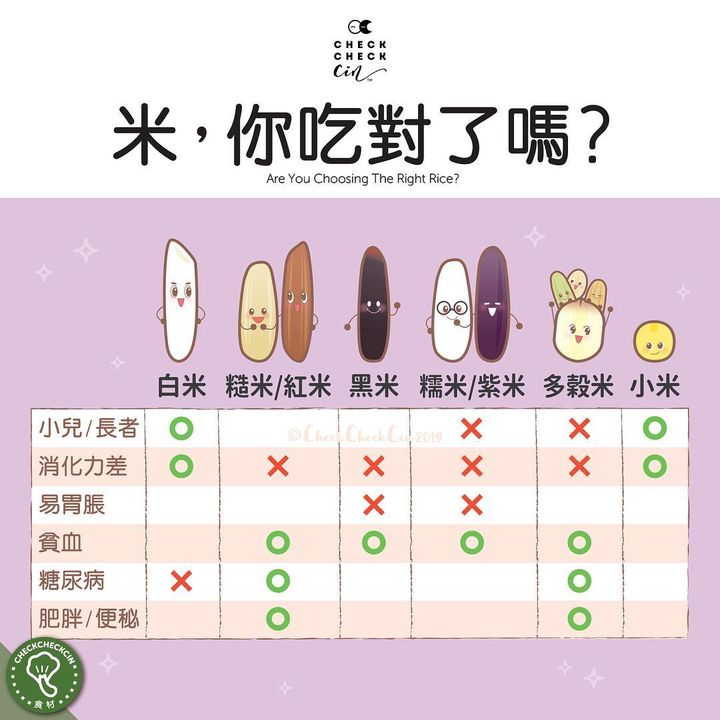March 28, 2019
【食材百科】你平日吃哪一種米?
米,你吃對了嗎?
米是香港人的主要糧食之一,隨著大家的健康意識提高,對米的要求亦越來越多,餐桌上除白飯,還會吃糙米、紅米甚至十五穀米,雖然都是米糧,但其實屬性和功效都大不同,每種米各有長短,配合自己體質就是最健康的食法。
白米 — 又稱粳米、大米,性平,可補中益氣、健脾養胃、除煩渴、長肌肉及止腹瀉,因為容易消化,尤其適合小朋友、老人家、病人及脾胃虛弱人士食用,但由於碳水化合物含量高,糖尿病人士要控制進食份量。
糙米 — 性平,稻米脫殼後的米,保留了粗糙的外層,口感較硬,和白米功效相約,適合有糖尿病、貧血、肥胖和便秘的人。消化力差人士不宜多吃。
紅米 — 是糙米的一種,性平,由於留有較多未磨走的表殼,更有營養,和白米功效相約,適合有糖尿病、貧血、肥胖和便秘的人。消化力差人士不宜多吃。
黑米 — 又稱黑粳米,性平,具滋陰補腎,益氣強身、明目活血的功效,有助改善頭髮早白、貧血、腰痠等問題。消化力差人士不宜多吃。
糯米 — 性溫,具補中益氣、健脾養胃、止瀉、止汗功效。注意扭傷、痛症患者、容易出現胃脹不適者不宜過量服用。要注意糯米性質黏滯滋膩,難以消化、容易礙濕,所以不宜過量食用,以免滯氣引起胃脹。消化力差及有濕疹者不宜多食,小兒及生病時更不宜食用。
紫米 — 又稱紫糯米/黑糯米,性溫,和糯米功效相約,能補氣健脾胃,改善身體虛弱、多汗、容易頭暈等症狀。適合氣血虛弱、陽虛體質人士。
五穀米/十穀米/十五穀米 — 是加入了多種穀物的米食,比白米含有更多纖維量及營養素,但亦因此不易消化,長者、小兒、脾胃虛弱者及痛風患者都不宜吃十穀米,適合糖尿病、貧血、肥胖和便秘人士食用。
小米 — 性涼,具益腎、補脾、養胃功效,由於容易吸收,適合老人、小兒、脾胃虛弱、消化吸收不良者食用。但由於性涼,胃寒人士勿食為妥。
Are you choosing the right rice?
Rice is an important part of diet in Hong Kong. As health awareness become stronger, the requirements for rice become higher as well. Many will also choose to eat brown rice, red rice or even 15 grains rice. They are all rice, but their nature and effects can be different. Each rice has their pros and cons, be sure to choose the right one for your body type.
White rice- mild in nature, can replenish vital energy and nourish qi, strengthen the spleen and nourish the stomach, relieve irritable thirst, promote muscle growth, and relieve diarrhea. As white rice is easy to digest, it is especially suitable for children, elders, those who are sick and those with asthenic weak spleen and stomach. Due to its high carbohydrate content, those with diabetes should consume with control.
Brown rice- mild in nature, it is unpolished rice with just husk of grain removed. It is stiffer in texture and effects are similar to white rice. It is suitable for those with diabetes, anemia, obesity and constipation. Those with weak digestive system should not have too much.
Red rice- it is a type of brown rice and mild in nature. More of the husk is not removed so it is more nutritious. The effects are similar to white rice. It is suitable for those with diabetes, anemia, obesity and constipation. Those with weak digestive system should not have too much.
Red rice- it is a type of brown rice and mild in nature. More of the husk is not removed so it is more nutritious. The effects are similar to white rice. It is suitable for those with diabetes, anemia, obesity and constipation. Those with weak digestive system should not have too much.
Black rice- mild in nature, and nourish yin and replenish kidneys, strengthen qi and body, improve vision and activate blood. Black rice can improve early onset of gray hair, improve anemia and lower back pain. Those with weak digestive system should not have too much.
Glutinous rice- warm in nature, can replenish vital energy and nourish qi, strengthen the spleen and nourish the stomach, relieve diarrhea, and relieve excessive sweating. Those with sprains, chronic pain, or those prone to abdominal discomfort should not have any. Note that glutinous rice is more sticky and heavier, which makes it more difficult to digest. It can also lead to stagnated dampness so do not eat too much of it as that can lead to abdominal bloating. Those with weak digestive system, with eczema, those who are sick and children should not have glutinous rice.
Purple rice- also known as black or purple glutinous rice. The effects are similar to glutinous rice, can replenish qi and strengthen the spleen and stomach, improve deficiencies in body, excessive sweating, and prone to dizziness. Suitable for those with asthenic weak qi and blood and those with yang deficiency.
5 grain/10 grain/15 grain rice- this is rice with multiple grains added in, making it more nutritious and higher in fibre content than white rice, but it also makes it harder to digest. Elders, children, and those with asthenic spleen and stomach and those with gout should not have multi-grain rice. It is suitable for those with diabetes, anemia, obesity, and constipation.



